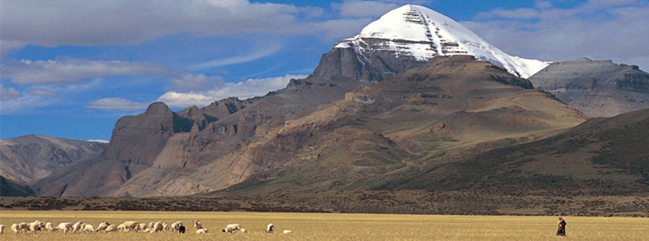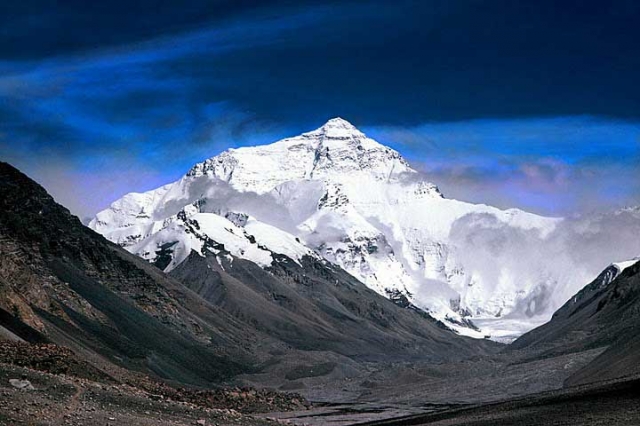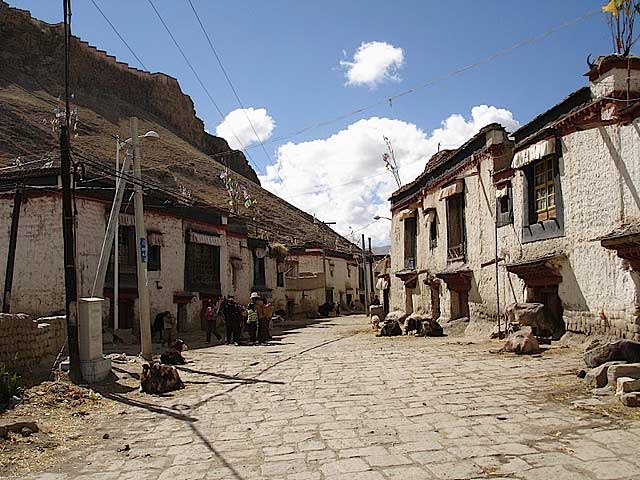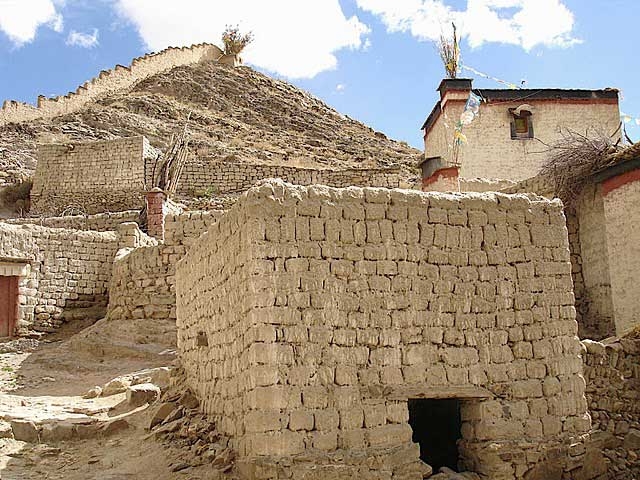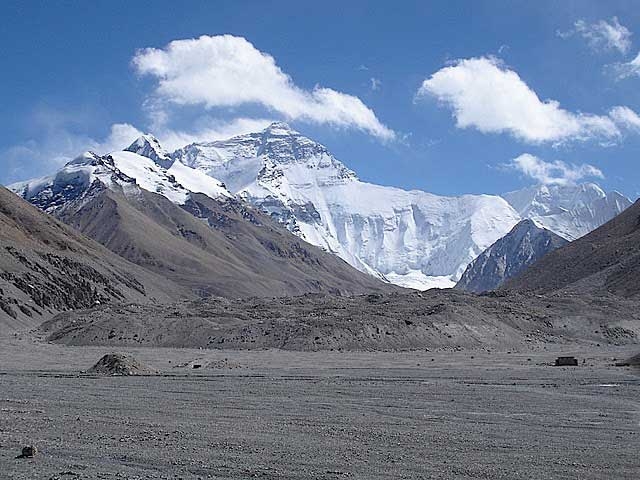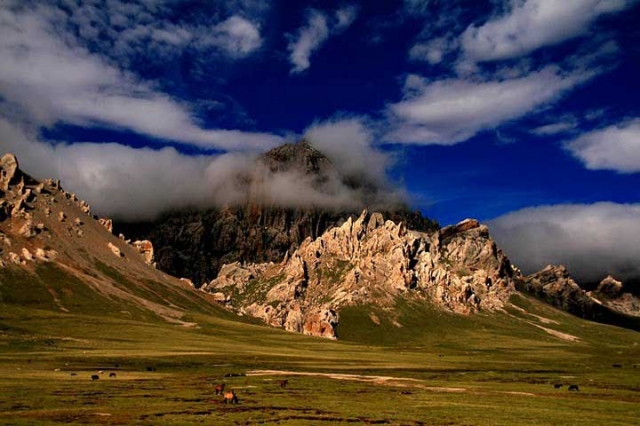The trek route leads through a magnificent mountain area, past villages of the Thakuri, along rivers and across the Nara Lagna Pass. From the 4580m high pass you can see the vast Tibetan plateau. You will hike to the Nepali/Tibetan border till the village of Sher on the Tibetan side, where a vehicle will pick you up and drive to Taklakot. Geographically you are directly south of Kailash, which Hindus and Buddhists view as the “center of the world”. On your way to the holy mountain you will wander along the western shore of Lake Manosarovar and camp. “There are countless beautiful landscapes in the Himalayas, in the Trans-Himalaya and in there areas of high Asia, Yet the view from Gosul Gompa cross the lake and the surrounding mountains surpasses everything I have seen”, wrote Sven Hedin in “Transhimalaya” (1909). The mighty rock dome of Kailash comes closer. Together with pilgrims from far and wide you follow the trail (Parikrama) across the Dolma La (5600m), which is adorned with countless prayer flags. It takes three days to circumambulate the snow-covered cupola of the 6714m tall mountain. In Tibetan tradition you will conclude this pilgrimage in Tirthapuri -which is one of the most important pilgrim destinations along with Kailash and Lake Manosarovar.
Almost surreal appears the canyon-like valley of the Sutlej. Imbedded lie the ruins of Tsaparang, the capital of the former kingdom of Guge. After visiting the 900 year-old site our drive through the canyon of the Sutlej starts long the north route to Lhasa. The light and shadows of the summer clouds make for a magical atmosphere, dip the barren vastness in tinges of pastel green, yellow deep blue and violet. En route, we visit two of the most sacred temples of Tibet: Tshilunpo in Shigatse and Kumbum in Gyantse. In Lhasa, the spiritual and secular center Tibet’s, visited by many pilgrims from allover the country, we will have two days at our disposal.
Day 01: Arrival Ktm transfer to Hotel
Day 02: Sight-seeing of Kathmandu: Leave for full day sightseeing in Kathmandu valley includes the Hindu temple complex at Pashupatinath (a UNESCO world heritage site) & the biggest Buddhist Stupa at Boudhanath. Also visit Monkey Temple the Swyambhunath (2000 years old temple) and visit Patan city of fine arts. Back to hotel and stay.
Day 03: Flight: KTM – Nepalgunj transfer to Hotel
Day 04: Flight: Nepalgunj – Simikot Trek to Dharapari, Camp
Day 05: Trek to Kermi, Camp
Day 06: Trek to Yalbang, Camp
Day 07: Trek to Muchu, Camp
Day 08: Trek to Yari, Camp
Day 09: Trek to Sip, Camp
Day 10: Drive to Taklakot, camp
Day 11: Drive to Manosarovar visit Rakshak Tal,camp
Day 12: Hike to Tseti Drive to Darchen, camp
Day 13: Trek to Dri ra Phuk, camp
Day 14: Trek to Zuthul Phuk, Camp
Day 15: Trek end and drive to Tirthapuri, Camp
Day 16: Drive to Toling, camp
Day 17: Visit Tsaparang, overnight in Toling, camp
Day 18: Drive to Ali / Shiquqn He
Day 19: Drive to Gertse – camp
Day 20: Drive to Tsochen – camp
Day 21: Drive to Lhotse, camp
Day 22: Drive to Shigatse visit Market, Hotel (BLD)
Day 23: Visit Tashilunpo, Drive to Gyantse, Hotel (BLD)
Day 24: Visit Khumbum Drive to Lhasa, Hotel (BLD)
Day 25: Lhasa: S/S – Sera, Drepung, Potala, Jokhang, hotel (BLD)
Day 26: Lhasa: S/S – Barkhor, Norbulingka, Hotel (BLD)
Day 27: Day trip to Gyanden if possible Sightseeing in Lhasa, hotel (BLD)
Day 28: Flight Lhasa – KTM, transfer to Hotel (BLD)
Day 29: Free day in Ktm, Hotel (BLD)
Day 30: Final departure transfer to onward destination
NOTE: The above information is a guide and standard template of what we provide. The trek can be customized at your request to accommodate your specific requirements.
Note : On adventure trips of this type, weather, local politics, transport or a multitude of other factors beyond our control can result in a change of itinerary. It is, however, very unlikely that the itinerary would be substantially altered; if alterations are necessary the leader will decide what is the best alternative, taking into consideration the best interests of the whole group. Where a change does occur, we do everything we can to minimize its effect, but we cannot be responsible for the results of changes or delays.
Q.What type of shape do I need to be in, is this trip for me?
A. Trekking is suitable for average people who are moderately fit, thus no previous experience is required. Some physical fitness programs such as running, swimming, hiking is recommended before you embark on your journey. Persons suffering from a pre-existing medical condition or disease must seek medical advice before considering the trek. Whilst on the trek, it is common to experience some discomfort before being fully acclimatized.
To prepare for a strenuous trek you should begin training at least two to three months before your departure. As a guideline, an hour of aerobic exercise three to four times per week would be considered a minimum requirement. The best preparation is bushwalking involving relatively steep ascents and descents. If you can manage a couple of valley floor to ridgeline ascents per comfortable and able to enjoy the trek to the fullest. They are physically strong, sharp-witted and have an incredibly positive attitude towards a life that we would consider extremely tough. There is something about a trek in the Himalaya that draws you back time and time again. For keen walkers it is a paradise and even avowed non-walkers find that one foot just seems to follow the other, drawn by the appeal of what lies beyond.
Q. Will somebody come to pick me up at the Airport upon my arrival?
A. Yes, our Airport Representative will be there to greet you outside of Terminal Hall, he/she will be displaying an Kiwi Adventures Treks & Expedition sign board. Upon arrival, you will be transferred to your hotel.
Q. What sort of accommodation can I expect in Kathmandu and in trekking?
A. 11 night’s Trekking Guesthouse, 4 nights three/four star hotels in Kathmandu.
We use standard rooms from three/four star hotels in Kathmandu with breakfast included. Along the trekking routes teahouses/Lodges generally provide basic clean facilities with a mattress and a quilt or blanket. We can also offer you sleeping bags if needed (which need to return after the trip) but it is a good idea to always have your own sleeping equipment. We usually provide single and double rooms as well as the occasional dormitory. The dining room is downstairs around a fire. All food will be cooked to order in the little kitchen. You should not enter the kitchen unless asked to do so.
Q. What sort of food can I expect in trekking?
A. In trekking most teahouses (lodges) cook a delicious range of mostly vegetarian fare. Pasta, tuna bakes, noodles, potatoes, eggs, dhal bhat, bread, soups, fresh vegetables (variety depends on the season) and even some desserts like apple pies, pancakes, and some interesting attempts at custard. You will find a lot of garlic on the menu because it assists with acclimatization – eat some every day. In many larger villages you may find some meat on the menu. You can always get hot chocolate, tea, and hot lemon drinks, as well as soft drinks, and treats like chocolate and crisps.
Each day dinner and breakfast are used to take in the same lodge you spend the night. Lunch will be taken on the way to destination.
Q. What sort of transportation you use?
A. Kiwi Adventures Treks & Expedition is all about providing you with local insights as well as adventure, with that in mind, where we think you will get more out of your holiday by using different means of transport that is what we do. Using a variety of private transport is an integral part of our Himalaya tours and enhances the experience!
We use private tourist vehicles for sightseeing, city tours and pickups. Depending on the group size we use cars, minibus, van or land cruiser. These small light vehicles are more manoeuvrable and flexible enabling us to take you through the Narrow roads of Nepal. All the vehicles are usually air-conditioned unless we are travelling in cooler areas.
Q. What is the best season for this trekking?
A. Our trekking season extends from mid- September to May. From early September the monsoonal rains decrease. By end of September through to December the weather is usually stable with mild to warm days, cold nights. February, March, April, May, October, November, December are the best time to do trek.
Q. What is the weather & temperature like in trekking?
A. Weather in the mountains is notoriously difficult to predict. At night it is generally cooler the days are generally warm. Winter (January and February) will be bit colder but the days can be quite beautiful and warm if the sun is out. There will be bit of snow during the month of January, February and December. It is also important to make sure that you can stay warm and dry in just about any conditions. Expect the unexpected! The temperature could be as high as 20 deg C to -15 deg C low.
Q. Can I charge my digital camera or other batteries on my trip?
A. These facilities will be available in most of the places in your hotel reception by paying some service charges. Remember to bring your adapters!
Q. Is there any communication while we are on trekking?
A. There are telephones in some villages along the trekking routes from which you can make international calls.
Q. Can I use credit cards in the places visit in trekking?
A. In most cities yes, to some extent, however once you leave those cities behind, all you need is cash.
Q. How much additional money do I need per day?
A. In Kathmandu, you can allocate US$ 10 – 25 for a lunch / dinner. It’s all depends on your spending habits. US$7 to 10 US$ a day will be enough to buy bottles of water, chocolates and few drinks in trekking.
Q. Do I need to tip my guide and porters? How much would that be?
A. This is a difficult thing to gauge. We have seen everything from 20USD to 1000 USD per person for guides and porters. Tipping is not required, but a small way to show your guides and local porters thanks for their help. The level of the tip should reflect the level of personal involvement with your guide.
Q. Is the water OK to drink? Do I need to bring purifying tablets/filter?
A. In most places bottled water is readily available. If you wish to drink normal water, you need to use purifying aid, which you will need to bring with you.
Q. Are the Kiwi Adventures Treks & Expedition staff insured?
A. Our company insures all our trekking staff, including guide, cook, sherpa and porters.
Q. What essential documents do I need to bring with me on tour?
A. *Valid Passport – must be valid for up to 6 months after you return from your tour, keep a separate photocopy.
*Travel insurance, keep a separate photocopy
*Cash and Traveller’s Cheques, keep numbers and proof of purchase separate
*Flight tickets
*Emergency contact numbers for T/C’s, banks, insurance, family contacts.
Q. Can I add extra days to my trekking trip?
A. A hoilday should never be about making it to the final point quickly. Along your trek we can add days at your request with additional costs to cover guides, porters, accommodation and food.
Q. Do you use yaks/porters on the trek or do we carry all of our own gear?
A. Whilst on the trek, our porter will take care of your luggage. All you need to carry is your small day bag for your personal belongings like camera, water bottle, sun cream etc only.
Q. What opportunities will I have for shower along the trek?
A. In major places, we arrange guesthouse with hot shower. And in rest of the places, hotel water in bucket will be provided for shower; it would cost you extra about USD 3-4 per shower.
Q. Do you know about how many total miles the trek is?
A. Total distance of the entire trek is about 75 miles.
Cost Includes
• 4 nights 3 stars hotel in KTM on B/B
• Sirdar, Cook, Sherpa, Kitchen boys,
• Helper, Yak & Yak man
• Food during the trek 3 meals a day
• 2 men tent, mattress, dinning tent,
• Kitchen tent, toilet tent, tables & chairs
• Insurance for all Nepalese staffs
• Flight Ktm-Lhasa
• Transportation: Zhangmu-KTM
• Lhasa hotel and lodge en-route on F/B
• Sightseeing in Tibet
• Local Tibetan guide
• Tibet entry & exit permit
• Transfer hotel-airport-hotel
• KTM sightseeing with guide
Cost Excludes
• Lunch & Dinner during KTM stay
• Entrance fees during KTM sightseeing
• Tibet Visa fee Euro 50 per person
• Personal equipment & Insurance
• International air ticket, airport tax
• Alcoholic beverages & telephone calls
• Nepal Visa fees US$ 30 Per person
• Emergency rescue evacuation if needed
